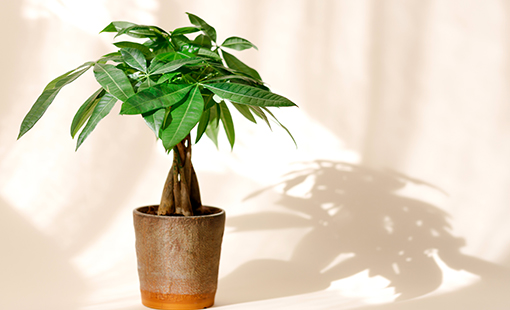
Money Tree Info & Care
The money tree, also commonly known as Guiana chestnut, is a species of tree native to Central and South America that has become an attractive houseplant thanks to its hardy nature. First popularized as a houseplant in Taiwan during the 1980s, the money tree is prominent among those who practice feng shui and is believed to create positive “chi,” or energy, in the home. Many cultures believe money trees bring good luck and prosperity. This alone has made it a staple in offices, banks and homes alike.
Money trees are most commonly sold as small plants with a braided trunk made up of three, five or seven stems. The trees are braided by nurseries when they are young and will continue to grow this way as they mature. Rarely are they started at home from seed, but if you do plan to plant the tree outdoors, you should start it from seed in the spring. The trees will grow quickly indoors or outdoors, often adding up to 24 inches a year in height.
Care
Although they can grow up to 60 feet in the wild, money trees kept indoors will typically only grow between 6 and 8 feet tall and can also be trained as a bonsai if you prefer to keep it small. The key to growing a money tree indoors is giving it the right amount of light and water. The good news is that it’s difficult to overwater money trees, which makes them ideal for people who have a tendency to kill their plants with too much TLC.
When grown outdoors, money trees produce stunning yellowish-white flowers, which are eventually replaced by large seed pods with peanut-like nuts inside. However, when grown indoors the plant does not flower, as it requires pollination to do so—a task that is typically carried out by bats in the wild. Despite this, when given the proper care indoors, money trees can flourish and increase the positive energy in your home at the same time.
Light
Outdoors, money trees can tolerate direct sunlight, but indoors they should be placed in bright to medium indirect light, for at least six hours a day. They will also do well under fluorescent light.
Soil
A well-draining, nutrient-rich potting soil is best for money trees. A peat moss-based mixture would be ideal, but a standard quick-draining soil mixture such as regular cactus or flower soil, will also work. If the soil requires more drainage, you can amend the mixture with sand or gravel.
Water
Money trees should be watered regularly, each time the top inch of soil is dry. Typically they will require more frequent watering in the spring and summer months and should be watered less frequently in the fall and winter. While money trees thrive with lots of water, be careful not to overwater them, as doing so can quickly kill them. The best way to avoid overwatering your plant is to ensure that the potting container and the soil have the proper drainage.
Temperature & Humidity
Money trees appreciate mild temperatures and high humidity. Generally, they should be kept between 65 and 75 degrees Fahrenheit, and not placed near any warm or cold drafts. Since home environments are typically dry, you can increase humidity around your money tree by placing it on top of a pebble tray filled with water, misting the leaves regularly, or using a small space humidifier.
Fertilizer
Fertilize your money tree monthly throughout the spring and summer, when the plant is actively producing new leaves, and bi-monthly throughout the fall and winter. A basic fertilizer blend that has been diluted to half-strength will work best.
Pruning
Pruning is an important part of caring for your money tree, especially if you wish to train the plant as a bonsai or control its size. Regular pruning of the lower leaves can also help to encourage new growth at the top of the plant.
Potting and Repotting a Money Tree
Repotting your money tree is only necessary if you want your tree to grow larger. If you want your money tree to stay small, keeping it in a small pot is one of the best ways to do so. When choosing a potting container for your tree, always ensure that it has ample drainage holes, as money trees don’t like their roots to sit in water and can easily develop root rot if proper drainage is not provided.
Common Pests & Diseases
Money trees are susceptible to a range of common houseplant pests when grown indoors, but are particularly prone to mealybugs and scale. If an infestation occurs, aim to treat the plant immediately using a mild insecticide or horticultural oil, like neem oil.
Information courtesy of TheSpruce.com

 Adams Fairacre Farms
Adams Fairacre Farms